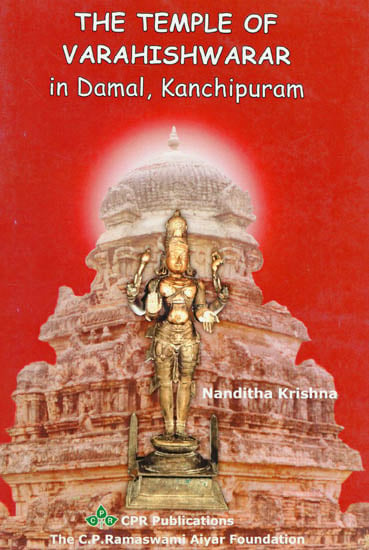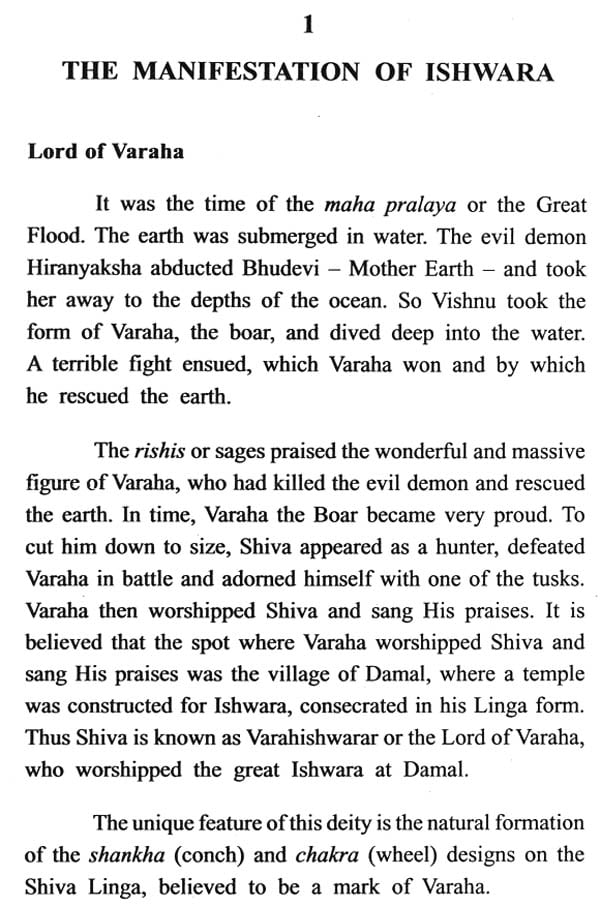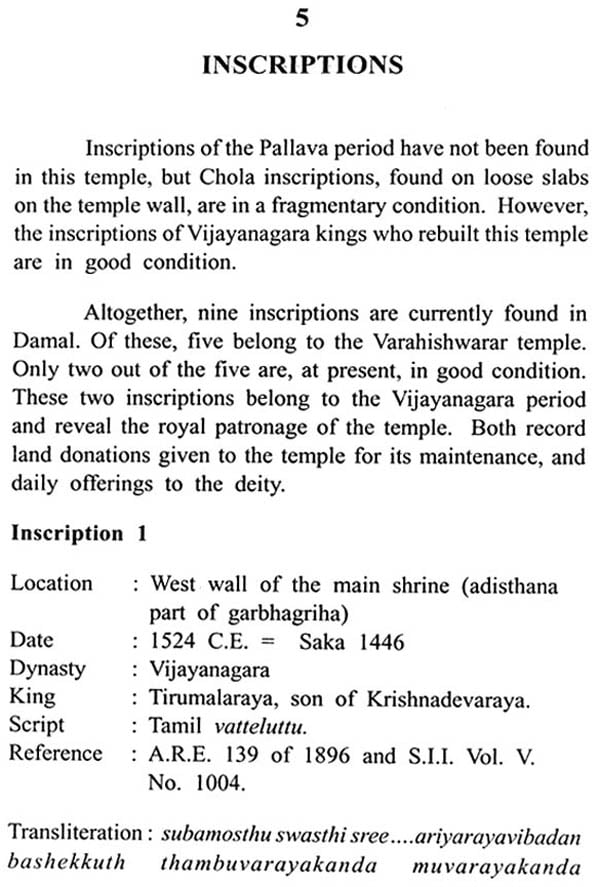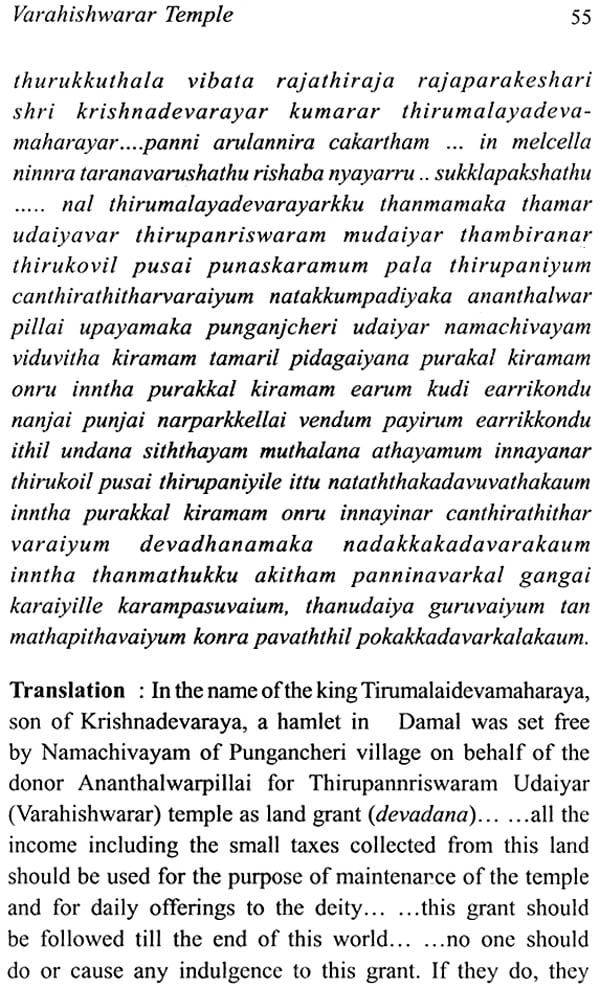
The Temple of Varahishwarar in Damal, Kanchipuram
Book Specification
| Item Code: | NAU042 |
| Author: | Nandita Krishna ( V.k Rajamani and P. Sudhakar ) |
| Publisher: | The C. P. Ramaswami Aiyar Foundation, Chennai |
| Language: | English |
| Edition: | 2014 |
| ISBN: | 9788190830553 |
| Pages: | 99 ( Throughout Color Illustrations ) |
| Cover: | PAPERBACK |
| Other Details | 8.00 X 5.50 inch |
| Weight | 140 gm |
Book Description
Rangammal, alias Pattammal, mother of Sir C.P. Ramaswami Aiyar, belonged to the village of Damal, where she had inherited several hundred acres of rice fields from her parents Venkatasubba Aiyar and Savitri Animal. Although they lived and maintained their home in Kanchipuram, it was Damal that gave them their considerable wealth, used by Venkatasubba Aiyar to purchase more properties in Kanchipuram and Madras (now Chennai). Rangammal was a considerable benefactor in the region and, even today, there are small mandapams on the Kanchi - Vellore highway that were built by Rangammal as resting places for voyage-weary travellers , besides water sources built by ancestors of Rangammal in Kanchi and on the highway beyond.
From the time we were children, the trip to Damal was an annual routine. My grandparents, Saraswathi and C.R. Pattabhi Raman, would pack all the children, dogs, servants and food into one or two cars and we would set of Our first stop was Conjeeverum (now Kanchipuram), and the next was Damal. My grandparents were very conscious that we should be aware of our heritage and the source of our prosperity. After a night at Damal, we would drive on to Bangalore to spend a couple of days with my grand uncle C.R. Venkata Subban before reaching Ootacamund , our summer destination and the home of my great grandfather, Sir C.P. Ramaswami Aiyar. Even though I grew up in far-away Bombay, I was always aware of Damal, for our annual rice requirements would be sent all the way from Damal to Bombay.
Thatha (as we called my great grand father Sir C.P. Ramaswami Aiyar) passed away in 1966, but my grand parents kept Damal alive for us, and the annual ritual visit continued during festivals and rituals for our family deities, Kamakshi Amman, Ekambreshwarar and Pralayankartha Amman of Kanchi. Rangammal had a tradition of making two sets of any jewellery she designed, one of which was given to Goddess Kamakshi of Kanchipuram. Her grandson, my grand father C.R. Pattabhi Raman, gifted his grand father 's famed blue diamonds —the tharuppu kal vairam , famous for their size and carats — to Kamakshi. During the annual utsavam of Lord Ekambreshwarar in the (Tamil) month of Panguni , our family undertook the hosting and feeding of the Brahmanas who performed the rituals in our house at Kanchi. The tradition continues to this day.
There was, till recently, a tunnel connecting the Varahishwarar temple at Damal to the Ekambreshwarar temple at Kanchi . It was used to warn Kanchi of impending invaders who were kept at bay by the warriors of Damal .
In 1990, Mr. Chellam (better known as "Chella Sir'), a retired schoolmaster of Damal, requested the C.P. Ramaswami Aiyar Foundation and the C.P.R. Environmental Education Centre to develop Damal as an eco-friendly village. The work started in the High School where a nursery, water recycling unit, rainwater harvesting unit and water channels were constructed, along with a large community smokeless chulha . The gate and the fence were also constructed and some furniture was gifted to the school. The students were asked to plant and maintain trees and the vegetable garden. Community smokeless chulhas were also constructed in the primary school and balwadi at Damal .
From 1991, the women of Damal village were involved by the Foundation in various income generation activities such as seed collection and marigold cultivation. Women were trained in first-aid techniques. A counselling center with a psychologist functioned from 1991 to 1993. Subsequently, workshops on nutrition, nursery raising, tree plantation, etc. were conducted for the women. The women and the local potter were also trained to construct clay smokeless chulhas for domestic use.
As a part of our efforts to clean and green the village, children from the Saraswathi Kendra Learning Centre for Children, another offspring of the Foundation, went to Damal in 1991 to clean the Varahishwarar Temple along with the students of the Damal Government School. Our chemist, the late N. Muthukrishnan, took up the chemical cleaning of the gopuram and the vimana. Then Gowri Ammal asked us to arrange for the renovation of the temple. I was not for — and continue to be against — a "renovation", as I felt that this temple, with its Pallava, Chola and Vijayanagara features, deserved to be retained in its original form. I, personally, would have preferred a restoration. But numbers won, and a renovation was preferred.
The Foundation then advertised on behalf of the Hindu Religious and Charitable Endowments (H.R. & C.E.) Board of the Government of Tamil Nadu, which had taken over the temple, calling for tenders for the renovation. It was awarded to Shri Subbiah Sthapathi, descendent of a traditional family of temple builders and sculptors of Kanchi. The Foundation then applied for and obtained a grant for the repair of the roof of the temple from the Government of Tamilnadu . The main structure, including the vimana , the garba griha, the open window of the sanctum and the front gate were renovated by the Foundation, which also chemically destroyed the plants and weeds growing on the roof the gopuram and elsewhere. The construction of the new structures - the three shrines for Devi, Ganesha and Kartikeya — were made possible by Their Holinesses, the Shankaracharyas of Kanchi.
During the years of our work in Damal, we photographed the temple and its carvings at various stages before and during the renovation. Many of the sculptures have deteriorated and disappeared out of either vandalism or neglect. We have also photographed some of the new structures, such as the vimana. P. Sudhakar, Assistant Director of the CPREEC, took the earlier and some recent photographs, while the late Shri. V.K. Rajamani, the well-known photographer, took the others.
Damal is a small and insignificant village in a large state and a larger nation. But it has contributed greatly to the protection of Tamil Nadu from northern and foreign invaders, taking the brunt of many a battle. In the last few centuries, it has been the guardian angel of the ancient city of Kanchi.
This book is the result of our research about Damal and the Varahishwarar Temple. I must particularly mention G Balaji , Y Pavitra , S.M. Sujatha and M Amirthalingam for contributing to this book in so many ways.
We have chosen to publish this book in two languages — Tamil for the people of Damal and English for the outsider. As we were approaching the publication date, my grand father C.R. Pattabhi Raman passed away on June 19th, 2001. My grand father was a great philanthropist who gifted much of his considerable inheritance in Chennai, Kanchipuram and Damal to the C.P. Ramaswami Aiyar Foundation and other charities, for the conservation and development of education, environment, society and culture. It was therefore decided to dedicate this book to his memory.
This is a small contribution of the Foundation and all its constituents — the C.P.R. Environmental Education Centre, C.P. Art Centre, C.P. Ramaswami Aiyar Institute of Indological Research, Saraswathi Kendra Centre for Children — to commemorate a small village with a great history that was closely linked with our founding fathers.
This book was originally published in 2001. This is a fresh edition in colour. We have not included the new gopuram , which is a tastless and unnecessary addition.
**Contents and Sample Pages**











